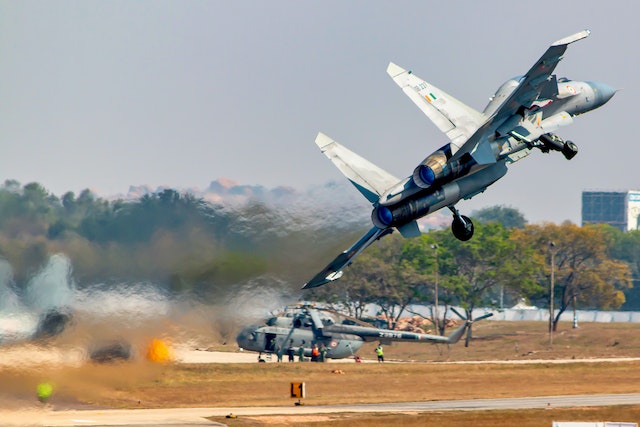
How high can a plane and helicopter fly? The world record for the highest a plane has managed to fly after taking off from the ground is 123,523 feet, or 37,649 meters. (The record stipulates taking off from the ground because planes that have flown higher than this are basically rockets with wings that have to be launched from another plane because they can’t fly in the lower atmosphere.) The world record for the highest helicopter flight is 12,954 meters, or 42,500 feet.
Planes and helicopters can fly because air is actually a substance with weight and density. Air is classed as a fluid, and it behaves like a liquid. Air will move from an area of high pressure to an area of low pressure, which is why we have winds. This moving air can carry things with it. The wings of a plane are shaped so that the air moves faster over the top of the wing than underneath it. As air moves faster, air density decreases, which lowers the pressure. The pressure above the wing is lower than the pressure below the wing and the air moves up into the low-pressure area, lifting the wing and lifting the plane.
A helicopter works on the same principle. The rotor blade is shaped so the air moves faster over the blade than under it, creating lower pressure, and creating lift. A helicopter has four blades to give it equal lift and balance. A helicopter also needs a tail rotor because it wants to spin in the opposite direction that the rotors are rotating. The tail rotor stops it from spinning.
In both of these cases, the plane and the helicopter need air to make them fly. That air needs to be a certain density to supply them with lift. The density of the air in the atmosphere decreases with height. This is partly because of gravity and partly because there are fewer air molecules pushing down on the air from above. Gravity pulls most of the air molecules closer to Earth. That means, as you go up, there are fewer and fewer air molecules, which also means they can spread out more. Density is a measure of how many molecules are packed into a certain space and as you get higher, there are fewer and fewer air molecules. Because of this, there will be a height where the plane cannot get enough lift from the surrounding air to overcome its weight, and it will fall out of the sky.
The height that a plane can reach depends on three things: the weight of the plane, the size of the wings, and the amount of thrust the plane has. A lighter plane will require less lift. Larger wings will produce more lift. The more thrust an aircraft has the more lift it will produce. So, a fully loaded 747 weighs about 440,000 kg, and it has wings that can produce enough lift for it to fly at about 10,600 meters. They can fly up to about 13,000 meters, but, if they go much higher, they won’t be able to get enough lift from the thin air. To make them go higher they would need to be lighter, have bigger wings, or have more thrust. An American U2 spy plane, however, can fly at over 21,000 meters because it is made of very light aluminium and it has very large wings. It needs less lift to fly and, at the same time, it can get more lift. The world record height of 37,649 meters was achieved with great speed and a very light load. A MiG-25 was flown as high and as fast as possible. The engines flamed out in the thin air but the plane had enough speed to continue gliding to the record height, before gliding far enough down that it’s engines could restart.
A helicopter cannot fly as high as a plane because it is constantly fighting its own drag. The spinning rotor blade provides lift, but the opposite blade is going against the air and always produces drag. Helicopters have to overcome this, which means they need thicker air. They also have much smaller (thinner) wings than a plane does, so they cannot get as much lift. A regular helicopter can probably reach about 3,000 meters and a turbine-engine helicopter can probably reach about 7,500 meters. To be able to go higher than this, the rotors need to rotate so fast that they would rip themselves apart. The world record height in a helicopter was achieved in a very light, specially adapted helicopter. The difficulty came because the engines couldn’t cope in the thin air. A plane can glide if its engines fail, but it is more difficult for a helicopter to glide.
So, helicopters are more limited in height than planes because they have smaller wings, are constantly fighting their own drag, and cannot glide easily. Planes can go higher if they can be made lighter, with bigger wings, and more power. And this is what I learned today.
Sources
https://www.quora.com/Why-cant-helicopters-fly-at-high-altitudes-thin-air
https://science.howstuffworks.com/transport/flight/modern/airplanes3.htm
https://science.howstuffworks.com/transport/flight/modern/helicopter6.htm
https://www.grc.nasa.gov/www/k-12/UEET/StudentSite/dynamicsofflight.html
https://www.virginexperiencedays.co.uk/experience-blog/how-high-can-a-helicopter-fly
